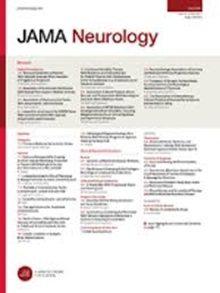Risk of Parkinson Disease in Individuals With Autism Spectrum Disorder.
IF 21.3
1区 医学
Q1 CLINICAL NEUROLOGY
引用次数: 0
Abstract
Importance Recent research suggests a plausible biological link between autism spectrum disorder (ASD) and Parkinson disease (PD). Nonetheless, large longitudinal studies examining the risk of PD following ASD are lacking. Objective To examine the association between ASD and future PD risk. Design, Setting, and Participants A nationwide population-based prospective cohort study was performed using data from Swedish national registers. All individuals born in Sweden from 1974 to 1999 with follow-up from age 20 years until December 31, 2022, and with complete covariate data were included. The analysis was completed in August 2024. Exposures Diagnoses of ASD as a time-varying exposure obtained from the National Patient Register. Main Outcomes and Measures Diagnoses of PD were obtained from the National Patient Register through 2022. The relative risk (RR) of PD was quantified using incidence rate ratios with 95% CIs from Poisson regression. Preterm birth, depression, antidepressant use, and antipsychotic exposure over time were potentially modifying life events. Results The study included 2 278 565 individuals (median [IQR] age at exit, 34 [29-42] years; 1 106 772 female [48.6%]), contributing 33 858 476 person-years. PD occurred in 438 of 2 226 611 individuals without ASD (0.02%; 1.3 cases/100 000 person-years) and 24 of 51 954 individuals with ASD (0.05%; 3.9 cases/100 000 person-years) (RR, 4.43 [95% CI, 2.92-6.72]). The risk estimates were similar after adjusting for sex, socioeconomic status, family history of mental illness, family history of PD, and age at ASD diagnosis. Preterm or early-term birth was not associated with and did not modify the PD risk. Depression and antidepressant use (present in 24 257 individuals with ASD [46.7%]) were associated with increased risk of PD (RR, 2.01 [95% CI, 1.40-2.88]), independent of ASD. Antipsychotic exposure (present in 16 387 individuals with ASD [31.5%]) reduced but did not fully attenuate the association (RR, 2.00 [95% CI, 1.27-3.14]) and showed no interaction with ASD on PD risk. Conclusions and Relevance ASD was associated with increased risk of PD, even after adjusting for depression or antidepressant use and antipsychotic exposure. These findings suggest a potential shared etiology between neurodevelopmental disorders and PD, and a heightened awareness of long-term neurological conditions in individuals with ASD may be warranted.自闭症谱系障碍患者帕金森病的风险
最近的研究表明自闭症谱系障碍(ASD)和帕金森病(PD)之间存在似是而非的生物学联系。尽管如此,还缺乏大型的纵向研究来检查ASD后PD的风险。目的探讨ASD与未来PD风险的关系。设计、环境和参与者:一项基于全国人群的前瞻性队列研究使用来自瑞典国家登记册的数据。所有1974年至1999年在瑞典出生的个体,随访时间为20岁至2022年12月31日,并纳入完整的协变量数据。该分析于2024年8月完成。暴露从国家患者登记中获得的ASD诊断为时变暴露。PD诊断的主要结果和测量方法来自截至2022年的国家患者登记册。PD的相对危险度(RR)采用泊松回归95% ci的发生率比进行量化。随着时间的推移,早产、抑郁、抗抑郁药物的使用和抗精神病药物的暴露都可能改变生活事件。结果共纳入2例 278 565例(退出时中位[IQR]年龄34[29-42]岁;1 106 772名女性[48.6%]),贡献33 858 476人年。2例中有438例发生PD 226 611例无ASD (0.02%;1.3例/100 000人年),51 954例中有24例患有ASD (0.05%;3.9例/100 000人年)(RR, 4.43 [95% CI, 2.92-6.72])。在调整了性别、社会经济地位、精神疾病家族史、PD家族史和ASD诊断年龄后,风险估计是相似的。早产或早产与PD风险无关,也不会改变PD风险。抑郁和抗抑郁药物的使用(在24 257名ASD患者中存在[46.7%])与PD风险增加相关(RR, 2.01 [95% CI, 1.40-2.88]),独立于ASD。抗精神病药物暴露(存在于16 387名ASD患者中[31.5%])降低了但没有完全减弱两者之间的关联(RR, 2.00 [95% CI, 1.27-3.14]),并且与ASD在PD风险上没有相互作用。结论和相关性即使在调整了抑郁症或抗抑郁药使用和抗精神病药物暴露后,easd仍与PD风险增加相关。这些发现表明,神经发育障碍和PD之间存在潜在的共同病因学,并且有必要提高对ASD患者长期神经系统疾病的认识。
本文章由计算机程序翻译,如有差异,请以英文原文为准。
求助全文
约1分钟内获得全文
求助全文
来源期刊

JAMA neurology
CLINICAL NEUROLOGY-
CiteScore
41.90
自引率
1.70%
发文量
250
期刊介绍:
JAMA Neurology is an international peer-reviewed journal for physicians caring for people with neurologic disorders and those interested in the structure and function of the normal and diseased nervous system. The Archives of Neurology & Psychiatry began publication in 1919 and, in 1959, became 2 separate journals: Archives of Neurology and Archives of General Psychiatry. In 2013, their names changed to JAMA Neurology and JAMA Psychiatry, respectively. JAMA Neurology is a member of the JAMA Network, a consortium of peer-reviewed, general medical and specialty publications.
 求助内容:
求助内容: 应助结果提醒方式:
应助结果提醒方式:


